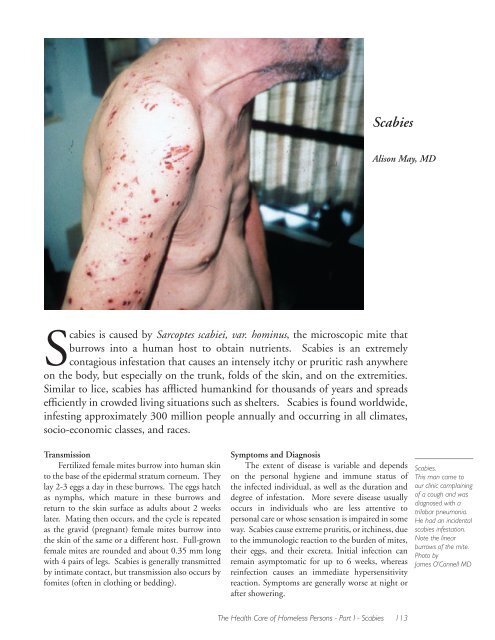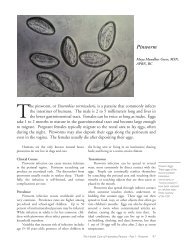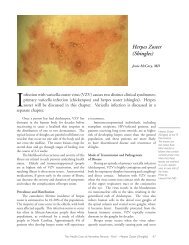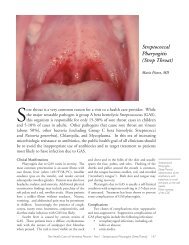Scabies - Boston Health Care for the Homeless
Scabies - Boston Health Care for the Homeless
Scabies - Boston Health Care for the Homeless
You also want an ePaper? Increase the reach of your titles
YUMPU automatically turns print PDFs into web optimized ePapers that Google loves.
<strong>Scabies</strong><br />
Alison May, MD<br />
<strong>Scabies</strong> is caused by Sarcoptes scabiei, var. hominus, <strong>the</strong> microscopic mite that<br />
burrows into a human host to obtain nutrients. <strong>Scabies</strong> is an extremely<br />
contagious infestation that causes an intensely itchy or pruritic rash anywhere<br />
on <strong>the</strong> body, but especially on <strong>the</strong> trunk, folds of <strong>the</strong> skin, and on <strong>the</strong> extremities.<br />
Similar to lice, scabies has afflicted humankind <strong>for</strong> thousands of years and spreads<br />
efficiently in crowded living situations such as shelters. <strong>Scabies</strong> is found worldwide,<br />
infesting approximately 300 million people annually and occurring in all climates,<br />
socio-economic classes, and races.<br />
Transmission<br />
Fertilized female mites burrow into human skin<br />
to <strong>the</strong> base of <strong>the</strong> epidermal stratum corneum. They<br />
lay 2-3 eggs a day in <strong>the</strong>se burrows. The eggs hatch<br />
as nymphs, which mature in <strong>the</strong>se burrows and<br />
return to <strong>the</strong> skin surface as adults about 2 weeks<br />
later. Mating <strong>the</strong>n occurs, and <strong>the</strong> cycle is repeated<br />
as <strong>the</strong> gravid (pregnant) female mites burrow into<br />
<strong>the</strong> skin of <strong>the</strong> same or a different host. Full-grown<br />
female mites are rounded and about 0.35 mm long<br />
with 4 pairs of legs. <strong>Scabies</strong> is generally transmitted<br />
by intimate contact, but transmission also occurs by<br />
fomites (often in clothing or bedding).<br />
Symptoms and Diagnosis<br />
The extent of disease is variable and depends<br />
on <strong>the</strong> personal hygiene and immune status of<br />
<strong>the</strong> infected individual, as well as <strong>the</strong> duration and<br />
degree of infestation. More severe disease usually<br />
occurs in individuals who are less attentive to<br />
personal care or whose sensation is impaired in some<br />
way. <strong>Scabies</strong> cause extreme pruritis, or itchiness, due<br />
to <strong>the</strong> immunologic reaction to <strong>the</strong> burden of mites,<br />
<strong>the</strong>ir eggs, and <strong>the</strong>ir excreta. Initial infection can<br />
remain asymptomatic <strong>for</strong> up to 6 weeks, whereas<br />
reinfection causes an immediate hypersensitivity<br />
reaction. Symptoms are generally worse at night or<br />
after showering.<br />
The <strong>Health</strong> <strong>Care</strong> of <strong>Homeless</strong> Persons - Part I - <strong>Scabies</strong> 113<br />
<strong>Scabies</strong>.<br />
This man came to<br />
our clinic complaining<br />
of a cough and was<br />
diagnosed with a<br />
trilobar pneumonia.<br />
He had an incidental<br />
scabies infestation.<br />
Note <strong>the</strong> linear<br />
burrows of <strong>the</strong> mite.<br />
Photo by<br />
James O’Connell MD
<strong>Scabies</strong> Rash.<br />
A popular eruption<br />
of <strong>the</strong> skin, with faint<br />
linear or wavy ridges<br />
where <strong>the</strong> mites<br />
have burrowed under<br />
<strong>the</strong> skin. This rash is<br />
intensely itchy.<br />
Photo by<br />
Irwin Freedberg MD<br />
The dermatological findings of scabies are<br />
generally ery<strong>the</strong>matous papules and excoriations,<br />
most commonly affecting <strong>the</strong> interdigital web<br />
spaces, wrists, elbows, anterior axillary folds,<br />
periumbilical area , buttocks, and <strong>the</strong> penis. Dark,<br />
slightly elevated linear epidermal burrows, generally<br />
up to 15 mm long, can also be found, usually in<br />
<strong>the</strong> interdigital web spaces or wrists. A vesicular dot<br />
at one end of <strong>the</strong> burrow can indicate <strong>the</strong> location<br />
of <strong>the</strong> mite. <strong>Scabies</strong> can also cause reddish-brown<br />
nodules, which are most frequently found in <strong>the</strong><br />
groin and male genitalia or in <strong>the</strong> axillae. Less<br />
commonly, scabies can present as a more bullous or<br />
vesicular eruption. The head, neck, palms, and soles<br />
are usually spared, except in infants and young children,<br />
in whom <strong>the</strong>se areas are frequently involved.<br />
Norwegian (or crusted) scabies is a severe<br />
variant that most commonly occurs in institutionalized,<br />
debilitated, or immunosuppressed individuals.<br />
The load of parasite is much higher (generally<br />
thousands of mites as opposed to 5-10 mites in<br />
more classic scabies), and <strong>the</strong> disease is <strong>the</strong>re<strong>for</strong>e<br />
much more contagious. This variant of <strong>the</strong> disease<br />
has a different appearance, with diffuse crusting of<br />
plaques and nodules. The nails can also become<br />
thickened with subungual debris. In some patients<br />
with Norwegian scabies, <strong>the</strong> lesions may be more<br />
hyperkeratotic and psoria<strong>for</strong>m, with little or no<br />
pruritis, all features which may delay diagnosis.<br />
Ano<strong>the</strong>r variant of scabies, S. scabiei var canis,<br />
causes dog mange and can infest humans who<br />
114 The <strong>Health</strong> <strong>Care</strong> of <strong>Homeless</strong> Persons - Part I - <strong>Scabies</strong><br />
have contact with <strong>the</strong> animal. The mite cannot<br />
reproduce on <strong>the</strong> human host, and <strong>the</strong>re<strong>for</strong>e no<br />
burrows are seen in this variant. Treatment of <strong>the</strong><br />
infested animal results in resolution of <strong>the</strong> human<br />
symptoms as well.<br />
Definitive diagnosis of scabies can be made<br />
microscopically by visualization of <strong>the</strong> mites, eggs,<br />
or a fecal pellet. Mineral oil should be dropped onto<br />
a burrow or unexcoriated papule, which should <strong>the</strong>n<br />
be unroofed by scraping with a sterile #15 scalpel<br />
blade. The material obtained should be examined<br />
under microscopic low power.<br />
Treatment and Complications<br />
Until recently, topical lindane 1% lotion<br />
(Kwell) was <strong>the</strong> standard treatment <strong>for</strong> scabies.<br />
Generalized seizures have been reported after<br />
repeated applications of lindane, and clinicians<br />
must exercise caution when using this medication.<br />
The risk seems to be greater in small children<br />
(because of <strong>the</strong>ir high surface area-to-mass ratio), in<br />
people with neurological disease, or when lindane<br />
is applied after a warm bath (vasodilation increases<br />
absorption). This toxicity, as well as concerns about<br />
possible resistance to lindane, have resulted in <strong>the</strong><br />
use of permethrin 5% cream (Elimite) as <strong>the</strong><br />
treatment of choice <strong>for</strong> scabies. A single application<br />
of permethrin is usually sufficient when applied to<br />
a clean and dry body after a tepid bath or shower.<br />
The entire skin surface should be covered from chin<br />
to toes with a thin layer of <strong>the</strong> agent, including <strong>the</strong>
area behind <strong>the</strong> ears, between <strong>the</strong> fingers and toes,<br />
<strong>the</strong> groin, between <strong>the</strong> buttocks, and under finger<br />
and toenails. The medicine should be left on <strong>for</strong><br />
8-10 hours and <strong>the</strong>n washed off. The patient should<br />
<strong>the</strong>n put on clean clo<strong>the</strong>s. The treatment may be<br />
repeated in 1 week if necessary. Permethrin is safe<br />
<strong>for</strong> children over 2 months of age.<br />
Though less desirable <strong>for</strong> <strong>the</strong> reasons already<br />
discussed, lindane 1% lotion (Kwell) may be used<br />
and should be applied in <strong>the</strong> same way as permethrin.<br />
Lindane should not be used in pregnant or<br />
nursing women or in young children.<br />
Ano<strong>the</strong>r alternative treatment is 6% precipitated<br />
sulfur in petrolatum which is safe in pregnancy, lactation,<br />
and <strong>for</strong> children younger than 2 months old.<br />
This medication is applied nightly <strong>for</strong> 3 consecutive<br />
nights and washed off completely 24 hours after <strong>the</strong><br />
final application. This agent is messy, stains, and<br />
has an odor, but it is quite effective.<br />
One oral regimen is available. A single dose<br />
of ivermectin 200 mcg/kg (Stromectol) has<br />
been found to be effective in healthy patients as<br />
well as in many patients with HIV infection and<br />
crusted scabies. Patients with severe disease may<br />
require a second or third treatment or may require<br />
concomitant treatment with a topical scabicidal<br />
agent. Experience with ivermectin in <strong>the</strong> treatment<br />
of scabies is limited, and its use should <strong>the</strong>re<strong>for</strong>e be<br />
considered experimental. Ivermectin should not be<br />
used in pregnancy or in children who weigh less<br />
than 15 kg.<br />
After treatment is completed, clothing and<br />
bed linens used during <strong>the</strong> 3 days preceding treatment<br />
should be discarded or machine washed in<br />
hot, soapy water and <strong>the</strong>n dried in <strong>the</strong> hot setting<br />
of a household dryer. The treatment of intimate<br />
contacts is recommended, even when <strong>the</strong>y are<br />
asymptomatic.<br />
In Norwegian scabies, topical agents should<br />
be applied to <strong>the</strong> scalp, under <strong>the</strong> nails, and to <strong>the</strong><br />
face excluding <strong>the</strong> areas surrounding <strong>the</strong> eyes, nose,<br />
and mouth. Multiple sequential regimens may be<br />
required. In addition, treatment with a keratolytic<br />
agent such as 6% salicylic acid may be necessary in<br />
order to assure adequate penetration of <strong>the</strong> scabicidal<br />
agents. Because of <strong>the</strong> extremely infectious<br />
nature of this variant, isolation of <strong>the</strong> index case is<br />
extremely important, and treatment of <strong>the</strong> environment<br />
as well as of exposed contacts is indicated.<br />
Pruritis may persist <strong>for</strong> several weeks after treatment<br />
<strong>for</strong> scabies, even though effectively treated<br />
patients are no longer infectious after one day.<br />
Antihistamines and calamine lotion are effective <strong>for</strong><br />
relief of <strong>the</strong>se symptoms. Topical steroids or glucocorticoids<br />
can be helpful in <strong>the</strong> relief of pruritis after<br />
successful treatment is completed.<br />
In addition to scabicidal agents, all patients<br />
should trim <strong>the</strong>ir fingernails. Permethrin should<br />
be reapplied to <strong>the</strong> hands whenever <strong>the</strong>y are washed<br />
during treatment.<br />
Repeated treatment with any scabicidal agent<br />
may cause an allergic contact dermatitis. O<strong>the</strong>r<br />
complications of scabies include secondary eczema<br />
or impetigo that are generally caused by Staphylococcus<br />
aureus. Oral antibiotics may be necessary to<br />
treat secondary bacterial infections. Some strains<br />
of streptococci have also been found to cause a<br />
The <strong>Health</strong> <strong>Care</strong> of <strong>Homeless</strong> Persons - Part I - <strong>Scabies</strong> 115<br />
(far left)<br />
Norwegian <strong>Scabies</strong>.<br />
This man with<br />
HIV/AIDS has<br />
Norwegian scabies of<br />
his feet with marked<br />
hyperkeratosis. Intense<br />
nocturnal pruritis is<br />
highly characteristic<br />
of <strong>the</strong>se often<br />
polymorphic lesions.<br />
Photo by<br />
Jon Fuller MD<br />
(near left)<br />
Sarcoptes scabiei.<br />
This mite causes<br />
scabies and is seen<br />
here under <strong>the</strong><br />
microscope.<br />
Photo by<br />
Howard Koh MD
superinfection that can lead to glomerulonephritis.<br />
Prevention and Control<br />
Prevention and control are largely described in<br />
<strong>the</strong> preceding sections. Mites can generally survive<br />
<strong>for</strong> around one day away from <strong>the</strong> human host, so<br />
surfaces that cannot be washed should be vacuumed.<br />
Close contacts of patients with scabies should be<br />
treated at <strong>the</strong> same time as <strong>the</strong> index case.<br />
Summary<br />
<strong>Scabies</strong> is an intensely pruritic eruption caused<br />
by a mite that burrows under <strong>the</strong> skin. It is highly<br />
contagious and is spread by close personal contact<br />
or by <strong>the</strong> sharing of clothing or linens. <strong>Scabies</strong> can<br />
be effectively treated by <strong>the</strong> application of topical<br />
<strong>Scabies</strong> Medication List<br />
Generic Brand Name Cost<br />
1% lindane lotion Kwell $<br />
permethrin 5% cream Elimite $$<br />
ivermectin 200 mcg/kg Stromectol $<br />
116 The <strong>Health</strong> <strong>Care</strong> of <strong>Homeless</strong> Persons - Part I - <strong>Scabies</strong><br />
agents. Prevention of spread of <strong>the</strong> disease is dependent<br />
on <strong>the</strong> appropriate laundering of clothing<br />
and linens, as well as treatment of close contacts of<br />
anyone who has scabies. E<br />
The author of this chapter gratefully acknowledges<br />
<strong>the</strong> invaluable contribution of Barry Bock, RN, who<br />
authored this chapter in <strong>the</strong> original Manual.<br />
References<br />
Maguire J, Spielman A. Ectoparasite infestations, arthropod bites and stings. In: Braunwald E, Fauci AS, Kasper DL,<br />
et al., eds. Harrison’s Principles of Internal Medicine. 15th ed. New York: McGraw-Hill; 2001:2622-2624.<br />
Meinking TL, Taplin D, Hermida JL, et al. The treatment of scabies with ivermectin. New England Journal of<br />
Medicine 333(1):26-30.<br />
Mathison GE. Of mites and men: lessons in scabies <strong>for</strong> <strong>the</strong> infectious diseases clinician Clinical Infectious Disease<br />
1998;27(3):646-648.<br />
Orkin M, Maibach HI. <strong>Scabies</strong> and Pediculosis. In: Wonsiewicz M, Englis MR, Bauer L, eds. Fitzpatrick’s Dermatology<br />
in General Medcine. 5th ed. New York: McGraw-Hill; 1999:2677-2680.







